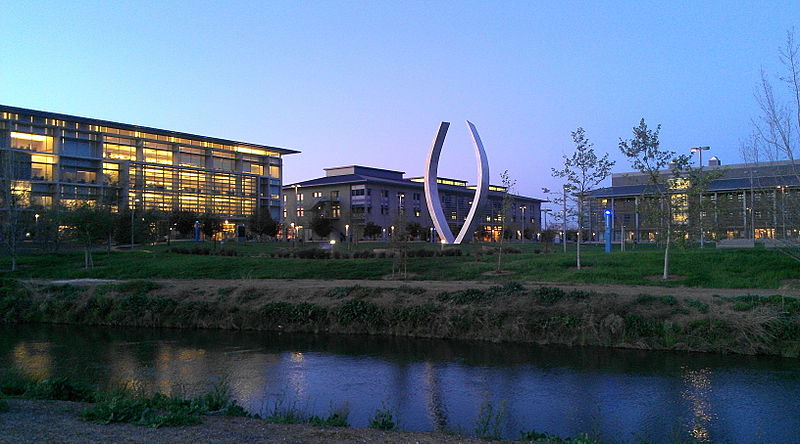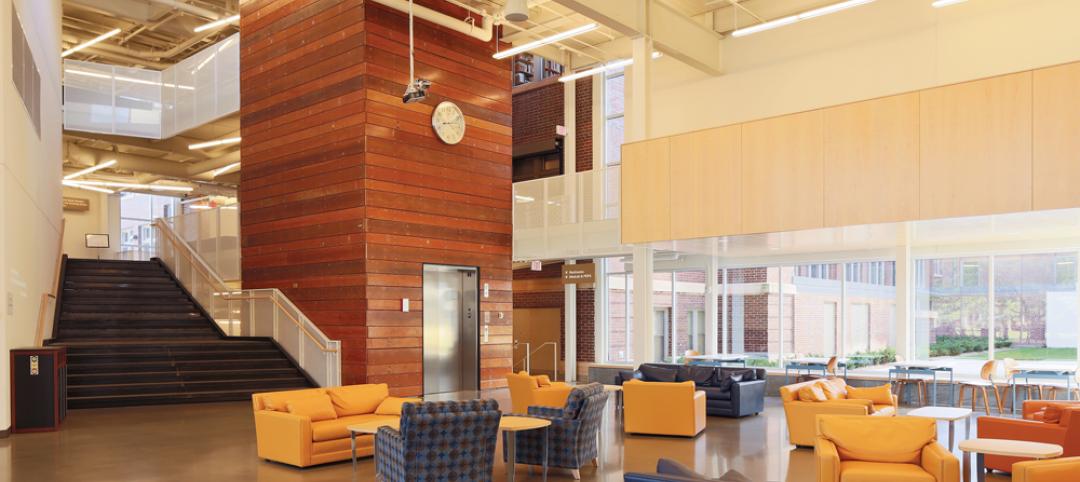The University of California, Merced, received another Leadership in Energy and Environmental Design (LEED) Platinum certification, this time for the Student Services Building.
The award brings the campus total for LEED certifications through the U.S. Green Building Council to 13, with its newest building, under construction, the second Classroom and Office Building (COB2), expected to also achieve Platinum status.
The campus is holding a topping-off ceremony for COB2 at 1 p.m. Tuesday, Dec. 9, with construction crews placing the uppermost beam on the building that’s expected to open in April 2016. Before the beam is placed, the campus community is invited to sign it, leaving marks and messages for anyone who might see it in the future.
UC Merced continues to be the only campus in the nation with LEED certification for all its facilities.
“UC Merced continues to pave the way in sustainable planning and design, frequently outperforming our objectives through the dedication and hard work of the consultants, contractors and staff involved and inspired by the vision of our leadership,” Campus Architect Thomas Lollini said.
The campus earned LEED Silver certification for the Garden Suites Lake View Dining building; eight Gold certificates for its Central Plant, Science & Engineering 1, the first Classroom and Office Building, the Leo and Dottie Kolligian Library, the Joseph Gallo Recreation Center, Sierra Terraces, Early Childhood Education Center and the Logistical Support/Safety Facility; and four Platinum certificates, for the dining expansion, the Social Science and Management building, the Student Activities and Athletic Center and now the Student Services Building. The Early Childhood Education Center is one of the first LEED Gold modular buildings in the country.
Platinum certifications are also pending on two residence halls, called The Summits, and on Science & Engineering 2, which opened this fall.
Earning LEED certifications for design is only one of the campus’s goals. The facilities department is also conducting audits of operations in every building on campus, from energy use to procurement procedures, to earn LEED recognition for the use and maintenance of the buildings.
The campus earlier this year won The California Architectural Foundation’s Owings Award for Environmental Excellence, recognizing UC Merced’s first development phase for its holistic view toward sustainability.
The campus’s master plan has won nine awards, including several from the American Institute of Architects, The Society of Campus and University Planners, the International Green Industry Hall of Fame, and the California Governor’s Environmental and Economic Leadership Award.
Though UC Merced has been honored for “cutting-edge sustainability in design and construction” of its buildings, the campus continues to undertake ambitious sustainability efforts, including its Triple Zero commitment to create zero landfill waste, consume zero net energy and produce zero net greenhouse gas emissions by 2020. The campus also plans to be nearly 90 percent powered by renewable energy by the end of 2016.
“There’s no other campus like UC Merced in the country,” Assistant Vice Chancellor of Strategic Facilities Planning Graeme Mitchell said. “This is a very special place.”
The campus pioneered the use of energy benchmarks, setting increasingly aggressive energy budgets for its buildings. Its buildings are designed to be 50% to 60% more energy efficient than their counterparts in the UC system, and 40 percent more water efficient.
Related Stories
| Nov 27, 2013
LEED for Healthcare offers new paths to green
LEED for Healthcare debuted in spring 2011, and certifications are now beginning to roll in. They include the new Puyallup (Wash.) Medical Center and the W.H. and Elaine McCarty South Tower at Dell Children’s Medical Center of Central Texas in Austin.
| Nov 27, 2013
University reconstruction projects: The 5 keys to success
This AIA CES Discovery course discusses the environmental, economic, and market pressures affecting facility planning for universities and colleges, and outlines current approaches to renovations for critical academic spaces.
| Nov 26, 2013
Construction costs rise for 22nd straight month in November
Construction costs in North America rose for the 22nd consecutive month in November as labor costs continued to increase, amid growing industry concern over the tight availability of skilled workers.
| Nov 25, 2013
Building Teams need to help owners avoid 'operational stray'
"Operational stray" occurs when a building’s MEP systems don’t work the way they should. Even the most well-designed and constructed building can stray from perfection—and that can cost the owner a ton in unnecessary utility costs. But help is on the way.
| Nov 19, 2013
Top 10 green building products for 2014
Assa Abloy's power-over-ethernet access-control locks and Schüco's retrofit façade system are among the products to make BuildingGreen Inc.'s annual Top-10 Green Building Products list.
| Nov 15, 2013
Greenbuild 2013 Report - BD+C Exclusive
The BD+C editorial team brings you this special report on the latest green building trends across nine key market sectors.
| Nov 15, 2013
Halls of ivy keep getting greener and greener
Academic institutions have been testing the limits of energy-conserving technologies, devising new ways to pay for sustainability extras, and extending sustainability to the whole campus.
| Nov 13, 2013
Installed capacity of geothermal heat pumps to grow by 150% by 2020, says study
The worldwide installed capacity of GHP systems will reach 127.4 gigawatts-thermal over the next seven years, growth of nearly 150%, according to a recent report from Navigant Research.
| Nov 8, 2013
S+T buildings embrace 'no excuses' approach to green labs
Some science-design experts once believed high levels of sustainability would be possible only for low-intensity labs in temperate zones. But recent projects prove otherwise.
| Nov 8, 2013
Walkable solar pavement debuts at George Washington University
George Washington University worked with supplier Onyx Solar to design and install 100 sf of walkable solar pavement at its Virginia Science and Technology Campus in Ashburn, Va.

















